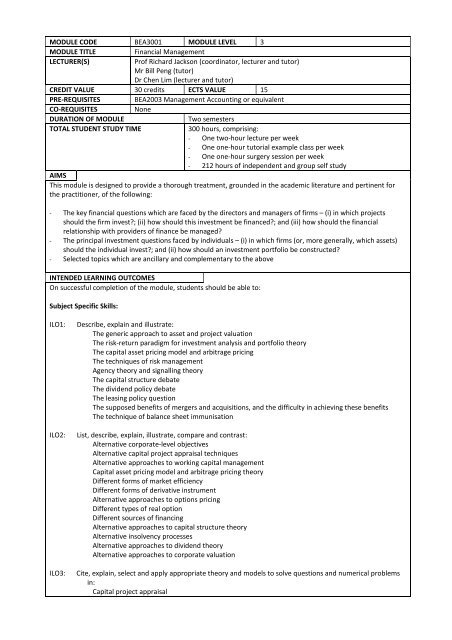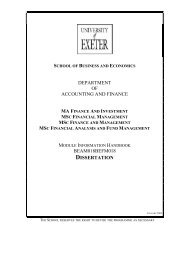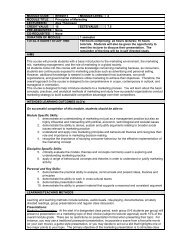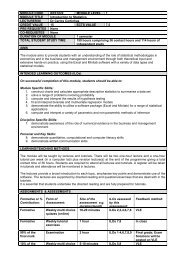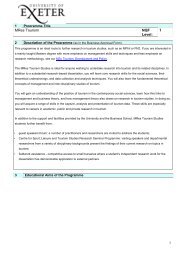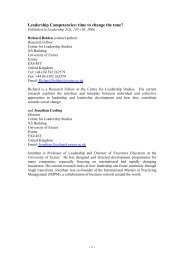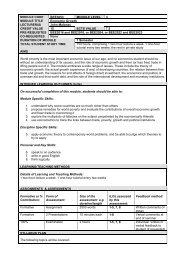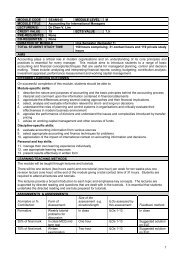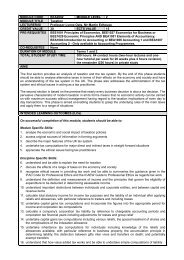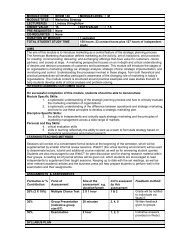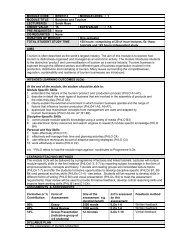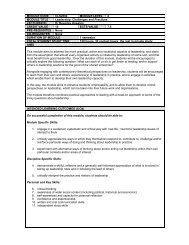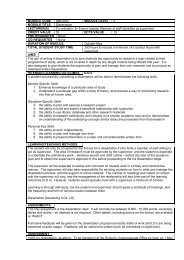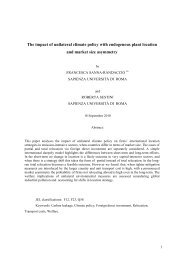MODULE CODE BEA3001 MODULE LEVEL 3 MODULE TITLE ...
MODULE CODE BEA3001 MODULE LEVEL 3 MODULE TITLE ...
MODULE CODE BEA3001 MODULE LEVEL 3 MODULE TITLE ...
Create successful ePaper yourself
Turn your PDF publications into a flip-book with our unique Google optimized e-Paper software.
<strong>MODULE</strong> <strong>CODE</strong> <strong>BEA3001</strong> <strong>MODULE</strong> <strong>LEVEL</strong> 3<br />
<strong>MODULE</strong> <strong>TITLE</strong> Financial Management<br />
LECTURER(S) Prof Richard Jackson (coordinator, lecturer and tutor)<br />
Mr Bill Peng (tutor)<br />
Dr Chen Lim (lecturer and tutor)<br />
CREDIT VALUE 30 credits ECTS VALUE 15<br />
PRE-REQUISITES BEA2003 Management Accounting or equivalent<br />
CO-REQUISITES None<br />
DURATION OF <strong>MODULE</strong> Two semesters<br />
TOTAL STUDENT STUDY TIME 300 hours, comprising:<br />
- One two-hour lecture per week<br />
- One one-hour tutorial example class per week<br />
- One one-hour surgery session per week<br />
- 212 hours of independent and group self study<br />
AIMS<br />
This module is designed to provide a thorough treatment, grounded in the academic literature and pertinent for<br />
the practitioner, of the following:<br />
- The key financial questions which are faced by the directors and managers of firms – (i) in which projects<br />
should the firm invest?; (ii) how should this investment be financed?; and (iii) how should the financial<br />
relationship with providers of finance be managed?<br />
- The principal investment questions faced by individuals – (i) in which firms (or, more generally, which assets)<br />
should the individual invest?; and (ii) how should an investment portfolio be constructed?<br />
- Selected topics which are ancillary and complementary to the above<br />
INTENDED LEARNING OUTCOMES<br />
On successful completion of the module, students should be able to:<br />
Subject Specific Skills:<br />
ILO1: Describe, explain and illustrate:<br />
The generic approach to asset and project valuation<br />
The risk-return paradigm for investment analysis and portfolio theory<br />
The capital asset pricing model and arbitrage pricing<br />
The techniques of risk management<br />
Agency theory and signalling theory<br />
The capital structure debate<br />
The dividend policy debate<br />
The leasing policy question<br />
The supposed benefits of mergers and acquisitions, and the difficulty in achieving these benefits<br />
The technique of balance sheet immunisation<br />
ILO2: List, describe, explain, illustrate, compare and contrast:<br />
Alternative corporate-level objectives<br />
Alternative capital project appraisal techniques<br />
Alternative approaches to working capital management<br />
Capital asset pricing model and arbitrage pricing theory<br />
Different forms of market efficiency<br />
Different forms of derivative instrument<br />
Alternative approaches to options pricing<br />
Different types of real option<br />
Different sources of financing<br />
Alternative approaches to capital structure theory<br />
Alternative insolvency processes<br />
Alternative approaches to dividend theory<br />
Alternative approaches to corporate valuation<br />
ILO3: Cite, explain, select and apply appropriate theory and models to solve questions and numerical problems<br />
in:<br />
Capital project appraisal
Working capital management<br />
Portfolio theory<br />
Asset pricing<br />
Market efficiency<br />
Options pricing<br />
Cost of capital<br />
Capital structure<br />
Dividend policy<br />
Corporate valuation<br />
Lease evaluation<br />
International aspects of financial management<br />
Mergers and acquisitions<br />
Balance sheet immunisation<br />
ILO4: Derive, criticise and challenge theoretical models for:<br />
Objective function of the firm<br />
Present value<br />
Working capital management<br />
Portfolio theory<br />
Complex covariance<br />
Capital asset pricing<br />
Value of an uncertain cash flow<br />
Capital asset pricing<br />
Option pricing via the Binomial method<br />
Put-call parity<br />
Value of the firm, cost of equity and weighted average cost of capital<br />
Value-relevance of dividend policy<br />
Balance sheet immunisation<br />
ILO5: Relate key financial issues one to another, to associated theory, to ‘real world’ evidence, and to the<br />
preferences and expectations of key stakeholders<br />
Core Academic Skills:<br />
ILO 6: (a) Develop powers of research in the academic literature and texts<br />
(b) Apply and criticise finance models in a ‘real world’ context<br />
(c) Develop powers of algebraic proof, derivation and criticism<br />
Personal and Key Skills<br />
ILO7: (a) Use information technology for information retrieval and numerical analysis<br />
(b) Build team skills in debating discussion topics and producing team solutions to problems<br />
(c) Build presentation skills in lecture / example class participation<br />
LEARNING/TEACHING METHODS<br />
Teaching and learning principally is organised into lectures, tutorial example classes and directed self-study. There<br />
are also regular surgery sessions to clear up student difficulties as they arise. Students are encouraged to work<br />
together in assimilating lecture material, preparing for tutorials and completing self-study assignments.<br />
All students are expected to attend all lectures and tutorials and complete all assigned work; and to attend surgery<br />
sessions as necessary. Much of the material will be covered by only one mode of delivery (lecture or tutorial or selfstudy).<br />
All material is potentially assessible, howsoever delivered.<br />
ASSIGNMENTS<br />
(Not for direct, summative assessment – see below for such)<br />
- Assigned work for each tutorial [ILOs 1, 2, 3, 4, 5, 6, 7]<br />
- Individual / group self-study assignments over the course of the two semesters [ILOs 1, 2, 3, 4, 5, 6, 7]<br />
ASSESSMENT<br />
- Two one-hour in-class multiple-choice tests (the first accounting for 5% module marks and the second for 15%<br />
module marks = 20% total) [ILO 3]
- One three-hour examination (accounting for 80% module marks) [ILOs 1, 2, 3, 4, 5]<br />
Should a re-sit be required for this module, it will be by means of one three-hour examination accounting for 100%<br />
module marks [ILOs 1, 2, 3, 4, 5]<br />
SYLLABUS PLAN<br />
1. Introductory topics<br />
2. Capital budgeting under conditions of certainty<br />
3. Working capital management<br />
4. Portfolio theory, capital asset pricing<br />
5. Capital budgeting under conditions of uncertainty<br />
6. Efficient markets<br />
7. Options pricing theory<br />
8. Sources of finance, cost of capital<br />
9. Capital structure<br />
10. Dividend policy<br />
11. Leasing<br />
12. Mergers and acquisitions<br />
13. Duration, convexity and balance sheet immunisation<br />
14. International aspects of financial management<br />
15. Aspects of risk and corporate valuation<br />
16. Review session<br />
INDICATIVE BASIC READING LIST<br />
The module recommended purchase text(s) (from which a number of the self-study assignments will be drawn) is:<br />
Brealey, R.A., Myers, S.C. and Allen, F. (2008), Principles of Corporate Finance, 9 th (International) Edition, McGraw-<br />
Hill.<br />
For wider reading, there are a large number of texts upon the subject areas of this module. Titles such as ‘Financial<br />
Management’, ‘Finance’, ‘Corporate Finance’, ‘Investments’, ‘Investment Analysis’ and similar may be found in the<br />
library and through any good book seller. Having the most up-to-date edition of such books is rarely important.<br />
Other materials / sources which you are expected to access and use during the module will be apprised to you<br />
during the module.<br />
RHGJ September 2008


